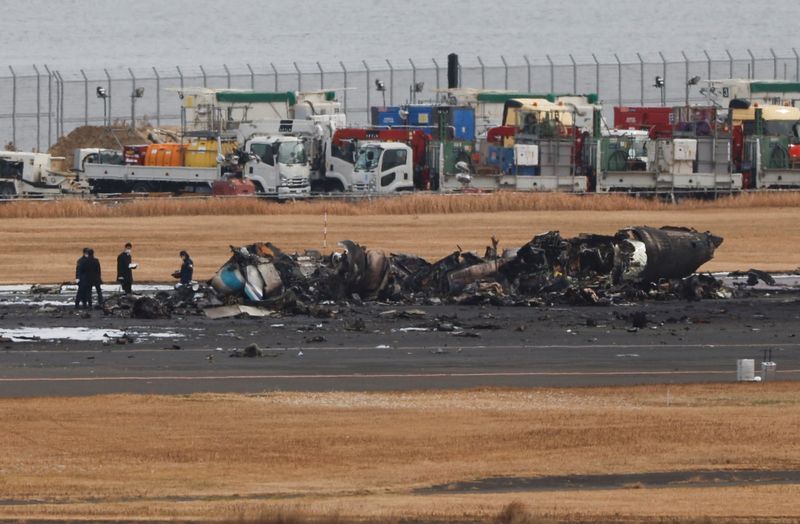By Maki Shiraki, Daniel Leussink and Lisa Barrington
TOKYO (Reuters) -Japanese authorities said on Wednesday a passenger jet that collided with a Coast Guard turboprop at a Tokyo airport had been given permission to land, but the smaller plane had not been cleared for take-off, based on control tower transcripts.
All 379 people aboard the Japan Airlines (JAL) Airbus A350 managed to evacuate after it erupted in flames following Tuesday's crash with a De Havilland Dash-8 Coast Guard turboprop shortly after landing at Haneda airport.
But five died among the six Coast Guard crew who were due to depart on a flight responding to a major earthquake on Japan's west coast, while the captain, who escaped the wreckage, was badly injured.
Authorities have only just begun their investigations and there remains uncertainty over the circumstances surrounding the crash, including how the two aircraft ended up on the same runway. Experts stress it usually takes the failure of multiple safety guardrails for an airplane accident to happen.
But transcripts of traffic control instructions released by authorities appeared to show the Japan Airlines jet had been given permission to land while the Coast Guard aircraft had been told to taxi to a holding point near the runway.
An official from Japan's civil aviation bureau told reporters there was no indication in those transcripts that the Coast Guard aircraft had been granted permission to take off.
The captain of the turboprop plane said he had entered the runway after receiving permission, a Coast Guard official said, while acknowledging that there was no indication in the transcripts that he had been cleared to do so.
"The transport ministry is submitting objective material and will fully cooperate with the ... investigation to ensure we work together to take all possible safety measures to prevent a recurrence," Transport Minister Tetsuo Saito told reporters.
The Japan Safety Transport Board (JTSB) is investigating the accident, with participation by agencies in France, where the Airbus jet was designed, and Britain, where its two Rolls-Royce (OTC:RYCEY) engines were manufactured. In Canada, where the Coast Guard Dash-8 was originally built by Bombardier (OTC:BDRBF), the TSB safety agency said it would also take part.
The JTSB has recovered the voice recorder from the coast guard aircraft, authorities said.
POLICE INQUIRY
Meanwhile, Tokyo police are investigating whether possible professional negligence led to deaths and injuries, several media outlets, including Kyodo and the Nikkei business newspaper, said.
Police have set up an investigation unit at the airport and plan to interview those involved, a spokesperson said, declining to say whether they were examining any suggestions of negligence.
Parallel air crash investigations have raised concerns in the past over tensions between civil safety investigations, which rely on open discussion of errors to help improve safety, and police-led inquiries, which are designed to apportion blame.
"There's a strong possibility there was a human error," said aviation analyst Hiroyuki Kobayashi, who is a former JAL pilot.
"Aircraft accidents very rarely occur due to a single problem, so I think that this time too there were two or three issues that led to the accident."
A notice to pilots in force before the accident suggested that a strip of stop lights embedded in the tarmac as an extra safety measure to prevent wrong turns, was out of service, according to a copy of the bulletin posted by U.S. regulators.
"This is something the investigators will look at," said U.S. aviation safety consultant John Cox.
In a statement on Wednesday, JAL said the aircraft recognised and repeated the landing permission from air traffic control before approaching and touching down.
All passengers and crew were evacuated within 20 minutes of the crash, but the aircraft, engulfed in flames, burned for more than six hours, the airline said.
The Coast Guard aircraft, one of six based at the airport, had been due to transport aid to regions hit by Monday's earthquake of magnitude 7.6 that has killed 64 people, with survivors facing freezing temperatures and prospects of heavy rain.
The accident forced the cancellation of 137 domestic, and four international flights on Wednesday, the government said.
But emergency flights and high-speed rail services were requested to ease the congestion, Transport Minister Saito said.

Michael Daniel, a former U.S. accident investigator, said investigators will be looking to make recommendations.
"The main thing is the situational awareness: what is it they would have told the pilot holding short of getting on a runway ... And then what was air traffic's understanding. Did the controller give them clearance to take off? ... A lot of that information will come out when they start reviewing the cockpit voice recorder as well as the air traffic tapes."